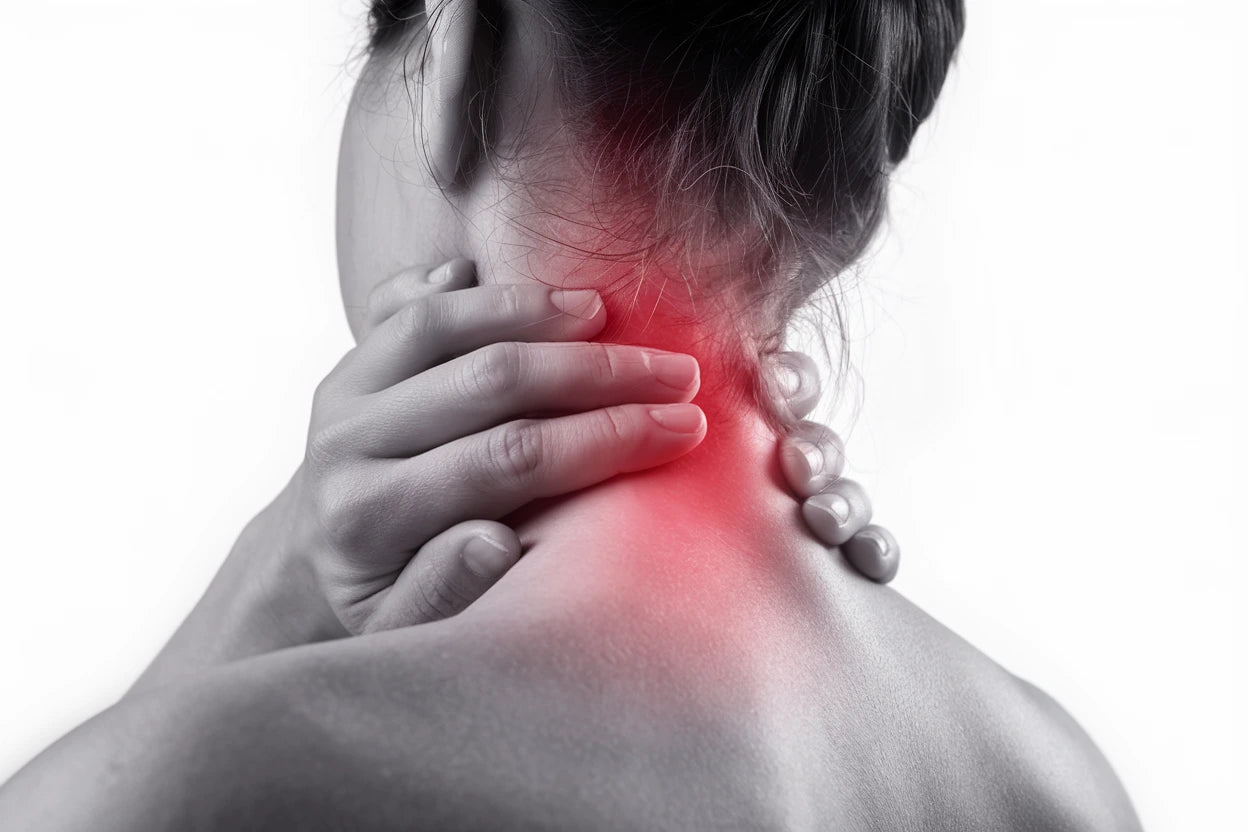Herniated Disc in the Neck: Symptoms, Causes, and Treatment

Herniated discs in the neck are a condition where a disc between the vertebrae in the neck bulges out and presses on nearby nerves. This can cause pain and other symptoms that affect the neck, shoulders, and arms. Herniated discs in the neck are one of the more common causes of severe neck pain and nerve impact in the upper extremities.
What Is a Herniated Disc in the Neck?
A herniated disc in the neck is an injury where a disc between the cervical vertebrae bulges out and presses on nerves. When the soft inner core of the disc (nucleus pulposus) protrudes through the outer fibrous casing, it creates compression on surrounding structures, especially nerve roots. This can cause pain, numbness, and stiffness. The condition is often treated with rest, medication, and physical therapy.
Herniated discs most commonly occur in areas of high mobility and load in the spine. In the neck, herniated discs at c5 c6 are particularly common, which can affect nerve function to the shoulder and arm.
How Herniated Discs in the Neck Feel - Common Symptoms
Common symptoms include:
- Neck pain, often intense and persistent
- Radiating pain from the neck to the shoulder, arm, and hand
- Numbness and tingling in the arm and hand
- Muscle weakness in the arm
- Reduced sensation in parts of the arm or hand
- Increased pain with certain movements, especially when bending the neck forward
The symptoms of herniated discs in the neck vary depending on which nerve root is affected. When a nerve or nerve root is compressed, it can lead to severe discomfort that impacts daily life for those affected. Neck pain is often the first sign, but most herniated discs also cause radiating symptoms along the path of the damaged nerve.
What Triggers Herniated Discs in the Neck - Common Causes
Several factors can contribute to the development of herniated discs in the neck:
- Aging-related wear on discs
- Overloading or improper loading of the neck
- Sudden injuries or trauma to the neck
- Poor posture over extended periods
- Genetic factors
The cause of herniated discs in the neck can often be linked to a combination of degeneration and strain. The condition sometimes arises without a clear reason, but certain positions and activities increase risk. Unlike herniated discs in the lower back, which are often related to heavy lifting, cervical disc herniation is more associated with prolonged static strain or inappropriate working postures.
Diagnosis and Treatment of Herniated Discs in the Neck
| Behandlingsmetod | Beskrivning | Fördelar med traktionskrage |
|---|---|---|
| Fysioterapi | Övningar för att stärka nackmuskulaturen | Ger avlastning och stöd under behandling |
| Smärtlindring | Antiinflammatoriska läkemedel vid behov | Kan minska behovet av medicin |
| Traktionsbehandling | Sträcker ut nacken för att minska trycket på nerverna | Traktionskragen möjliggör behandling hemma |
| Kirurgi | I svåra fall där konservativ behandling inte hjälper | Kan potentiellt förebygga behov av operation |

How a Traction Collar Can Help with Neck Herniated Discs
The traction collar from Komforten offers several benefits for individuals with neck herniated discs:
- Provides relief and stretches the neck to reduce pressure on the nerves
- Can be used at home for regular treatment
- Helps improve posture and reduce strain on the neck
- May contribute to faster healing and pain relief
- Non-invasive option that complements other treatment methods
Many patients with neck herniated discs take sick leave during the acute phase. The traction collar can then be a valuable tool for managing symptoms during recovery. It supports the natural curve of the neck and helps relieve pressure on the herniated disc during the healing process.
Buy nowSummary and Prognosis for Herniated Discs in the Neck
Herniated discs in the neck can be a painful and limiting condition, but with the right diagnosis and treatment, most individuals can experience significant improvements. By combining conservative treatment methods such as physical therapy and the use of aids like traction collars, many can effectively manage their symptoms and improve their quality of life. It is important to consult a doctor for an accurate diagnosis and individualized treatment plan.
Many herniated discs heal spontaneously over time, and with appropriate treatment, discomfort can often be significantly alleviated. Learn more about specific exercise methods for herniated discs in the neck and rehabilitation exercises to strengthen the supporting muscles around the spine.
Frequently Asked Questions (FAQ)
How long does it take for a herniated disc in the neck to heal?
Can I exercise with a herniated disc in my neck?
Light exercise and specific movements are often recommended as part of the treatment. Neck herniated disc exercises should focus on strengthening the neck muscles without overloading the injured disc. Consult a physiotherapist for a tailored program.
How do I use the traction collar for a herniated disc in the neck?
Follow the instructions that come with the product and consult your doctor or physiotherapist for personal recommendations. The collar should generally not be used continuously throughout the day.
Is surgery always necessary for a herniated disc in the neck?
No, most cases of herniated discs in the neck can be treated conservatively without surgery. Surgery is usually considered only when other treatments have failed or in cases of severe nerve involvement.
Can the traction collar prevent future herniated discs?
While the traction collar is primarily used for treatment, regular use can potentially help prevent overload and reduce the risk of future problems. However, it is important to combine this with exercise and good ergonomics.
